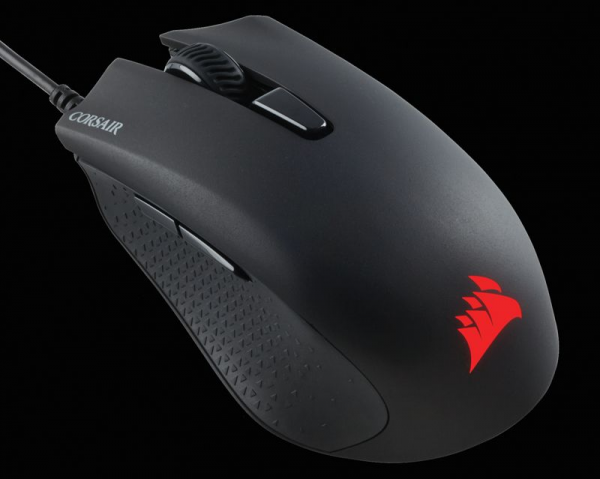Corsair
Corsair Harpoon RGB: an affordable and complete little mouse
Aprox. 24€
See specificationsFaced with the escalation of mouse for gamers, always better equipped, always more expensive, Corsair offers its Harpoon RGB, a small mouse that goes straight to the point with its 6 buttons, its optical sensor at 6000 dpi and an RGB backlight for stay on trend, all in a light and handy template. Above all, it is displayed at the recommended retail price of € 29.90, which immediately places it among the cheapest gaming mice on the market.
Positive points
Light and compact.
Convincing grip.
Satisfactory optical sensor.
Good finish with regard to pricing positioning.
Bad points
Slice buttons not necessarily very easy to handle for large fingers.
For right-handers only.
Our review
Ergonomics
The Corsair Harpoon RGB comes in the form of an unpretentious little wired mouse, with a rather common design. We find however the small aesthetic particularity of the manufacturer's mice with a vacuum at the level of the wheel, between the main buttons. The Corsair logo for its part appears on the top, at the base of the mouse, and constitutes the only backlit area. The latter is illuminated by an RGB LED and can vary in color and intensity depending on several effects offered in the CUE software (see box at the end of the test).
In terms of manufacturing quality, if the all-plastic leaves no doubt as to the entry-level positioning of the mouse, it must be recognized that the finishes are neat. The grainy matt black plastic used on the top of the shell has the advantage of being non-slip and not very dirty, failing to offer a very pleasant touch. If one prefers the softer feel of the coating used on the higher models of the range, the Harpoon nevertheless has little to envy other much more expensive mid-range mice.
With its dimensions (111.5 x 68.3 x 40.4 mm for 85 g), the Harpoon is much less imposing than its big sisters Saber and M65 Pro, for example, which makes it more suitable for fast games like FPS. Its compact shape invites a grip with the fingertips (finger tip) or claw grip (claw grip) rather than with the palm (palm grip), since the fingers quickly tend to protrude in this last position, unless not to have big hands.
The fact remains that comfort is at the rendezvous, thanks in particular to the recesses coated with an elastomeric material on the edges which make it possible to wedge the thumb, ring finger and little finger to grip the mouse well and lift it easily. The main buttons are also slightly hollowed out to better accommodate the fingers. Certainly, we do not reach the comfort of a little more imposing mice, like the Saber or M65 Pro, but the shape is well enough studied to limit fatigue. The Harpoon, however, is only intended for right-handers because of its asymmetrical shape and the tilt to the right of its hull.
Despite its entry-level mouse status, the Harpoon RGB does not skimp on the buttons. In addition to the two main buttons which are based on Omron switches and produce reactive clicks if not silent, the mouse incorporates a sensor sensitivity change button which overlooks the wheel. We can easily switch on the fly between the 5 sensitivity levels configured via the CUE software, with a little gymnastics of the index. The knob on the wheel, on the other hand, is fairly easy to operate, but a bit noisy.
On the left edge, the last two additional buttons fall well under the thumb, but their small size and the lack of differentiation, or at least frank separation between the two, can complicate their activation in the rush (fast action in a game .. .). Likewise, their slightly recessed position under the shell will not necessarily make them easy to handle with large fingers.
Regarding gliding, despite the small size of its PTFE pads, the Harpoon RGB moves easily thanks to its lightness, on a bare desk as on a carpet, even if we always advise to use a good carpet mouse to smooth movements, reduce sliding noise and limit wear on skates.
Precision
The Harpoon RGB is equipped with a PixArt PMW3320 optical sensor which supports accelerations up to 20 g and a maximum speed of 2.03 m / s. The native sensitivity of 3500 dpi is for its part quite sufficient, even if Corsair logically pushes it to 6000 dpi, probably not to worry players who still think that such a sensitivity is really exploitable. Remember that even at 3500 dpi, a movement of less than 3 cm is enough to move the cursor from one end to the other of an Ultra HD screen (3840 pixels wide), then at 6000 dpi ...
In practice, the mouse behaves as one might hope, that is to say with a certain dynamism made possible by its compact size and its lightness which will be appreciated by users adept at playing in low sensitivity. The optical sensor easily follows the fastest movements, even if the most nervous players may turn to a faster model, for safety. We would also have appreciated a shorter lift-off height of the sensor to completely eliminate small parasitic movements during rapid replacements of the mouse on the mat.
The sensor accommodates many surfaces, except those that are too shiny, reflective or transparent. In any case, our semi-gloss office posed no problem for him, and even the glossy magazine covers were not an obstacle.
Conclusion
Handy, well equipped and inexpensive, the Harpoon RGB will meet the expectations of most users who do not want to spend too much to enjoy a good mouse for the game. A new benchmark in value for money.
Specifications

